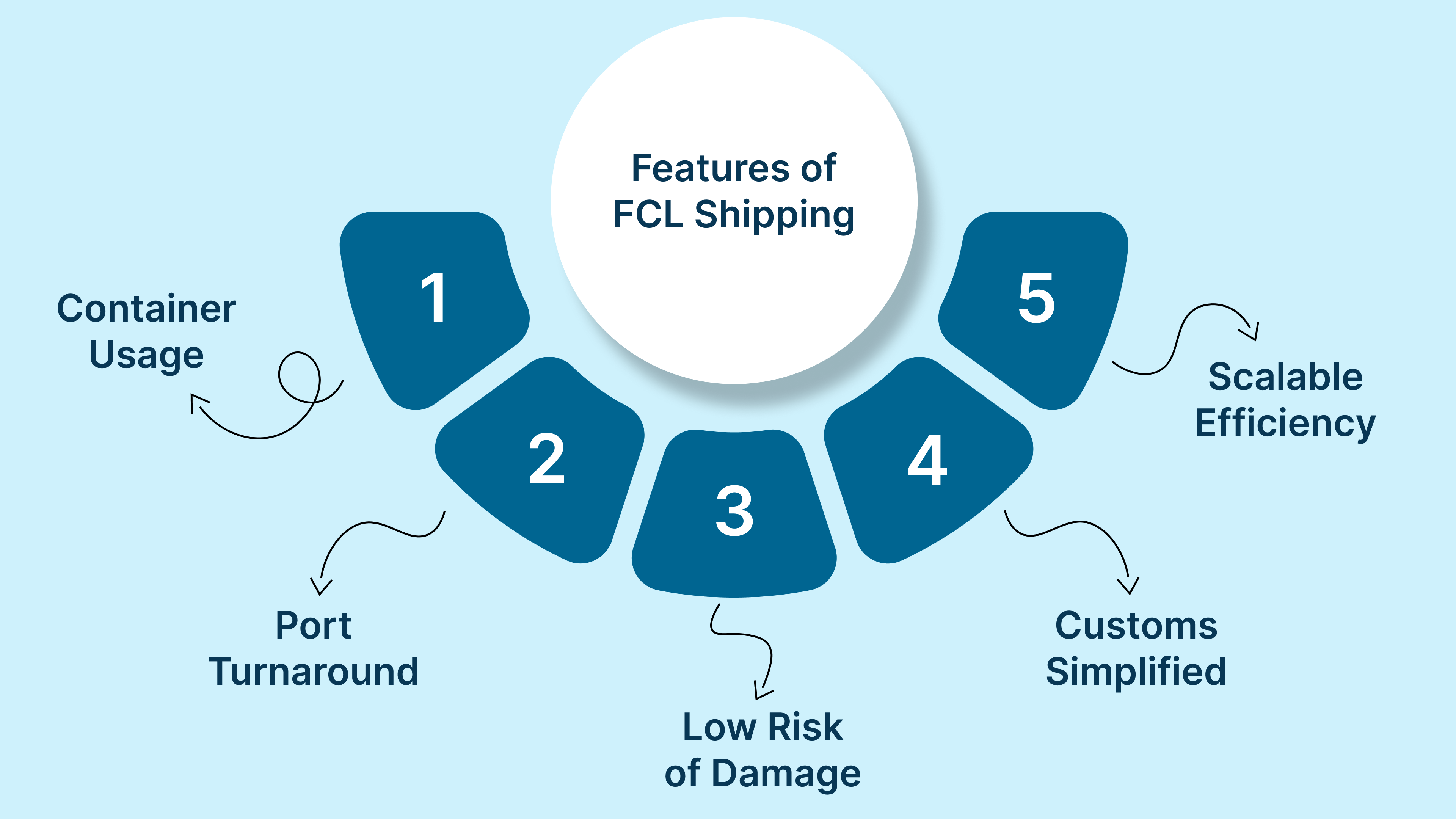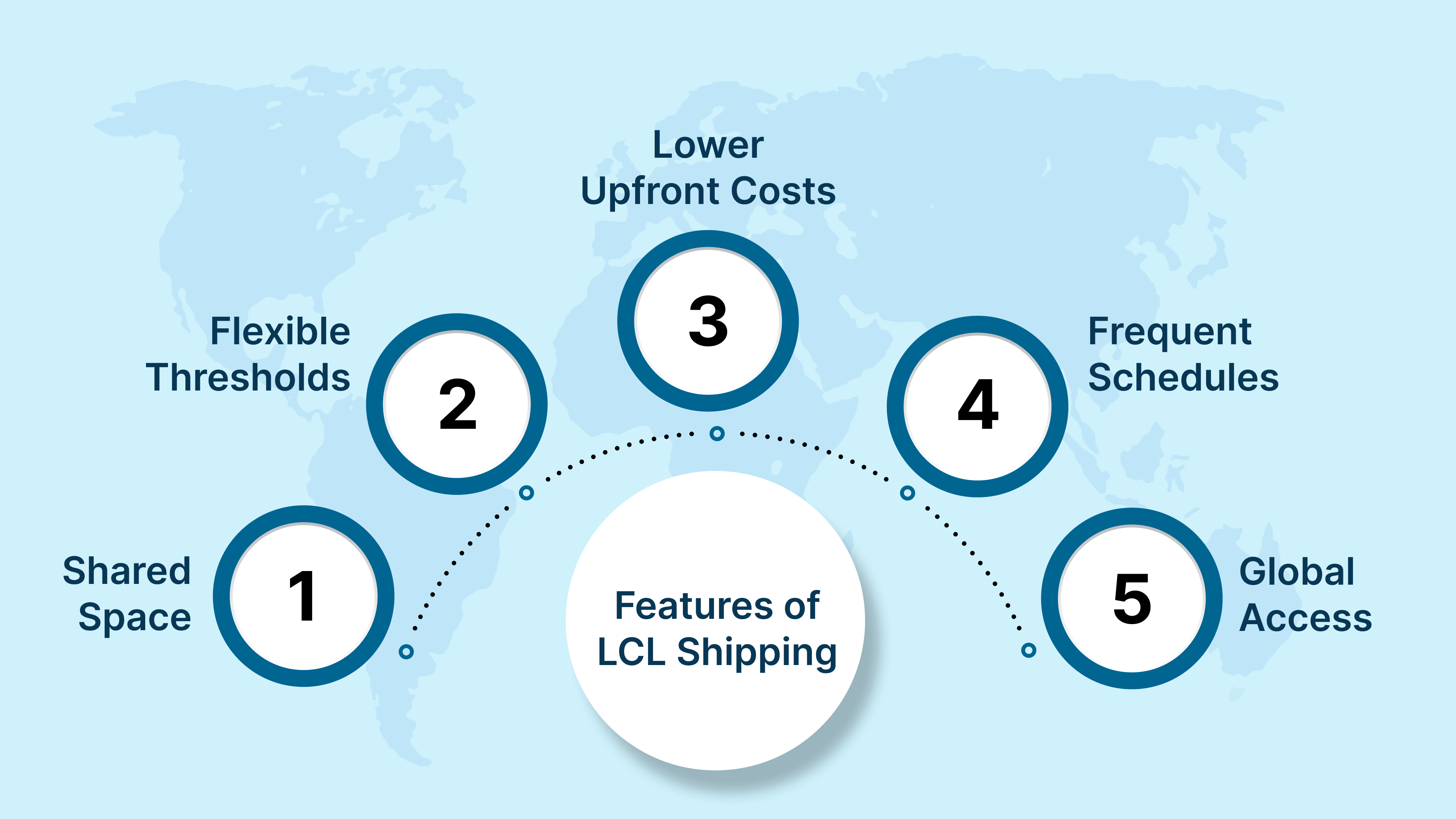Which shipping method aligns best with your business needs: FCL or LCL?
The freight forwarding market in the Philippines is experiencing significant growth. By 2025, the volume of goods transported is projected to reach 322.48 billion ton-kilometers (TKM), reflecting the country’s expanding role in global trade.
FCL offers dedicated space and faster timelines for bulk shipments, while LCL provides flexibility and cost efficiency for smaller loads.
Full Container Load (FCL) shipping refers to a method where your goods occupy an entire container, typically 20 feet or 40 feet in length, regardless of whether it’s filled. This mode is commonly used for larger shipments that benefit from dedicated space, more control, and faster transit times.
If you’re importing products in bulk or dealing with high-demand SKUs, FCL gives you a streamlined shipping process with fewer touchpoints. You avoid the delays and risks that can come from sharing space with other shippers, making it a strong choice for businesses looking to maintain consistency and scale efficiently.
As the Philippines improves its shipping infrastructure, indicated by a rise in the Liner Shipping Connectivity Index (LSCI), a measure of a country’s integration into global shipping networks, from 100 in Q1 2023 to 179.51 by Q2 2024, FCL shipping becomes more viable for businesses.
Next up, let’s take a closer look at when opting for FCL makes the most sense for your business.
FCL is ideal when shipment volume is high enough to justify the cost of the entire container. But it’s not only about spaceit’s also about speed, reduced risk, and simplified logistics.
Here’s when choosing FCL makes practical sense:
For retailers preparing for peak seasons or businesses replenishing large volumes of stock, FCL ensures better timeline control and fewer logistical variables. Now that we know when FCL is the right choice, let’s dive into the specific features that make it an attractive option for larger shipments.
Also read: Understanding ASN: Advanced Shipping Notice Explained

FCL offers a set of advantages that make it highly effective for businesses moving goods across borders on a large scale. These features enable more efficient planning, greater control over logistics, and long-term cost savings.
Prevent internal trade disruptions by streamlining your customs workflows with Inspire Solutions Asia.
Schedule a call today.FCL is best suited for businesses that prioritize control, consistency, and the ability to meet demand without disruption, especially when managing recurring imports or preparing for sales-driven spikes in orders. With that in mind, let’s now move on to understanding how LCL shipping compares in terms of flexibility and cost-effectiveness.
Less than Container Load (LCL) shipping refers to a method where your goods share a container space with cargo from other businesses. It’s designed for smaller shipments that don’t require a full container, making it a cost-efficient way to import or export without overcommitting on volume.
LCL shipping is beneficial for e-commerce startups, SMEs, and growing retailers who are still testing new products or markets. You only pay for the space you use, which helps reduce upfront investment while maintaining access to global suppliers and inventory sources.
Before we look into the specifics of when LCL might be your best option, let’s first take a look at some scenarios where it could shine.
LCL is the practical choice when your shipment isn’t large enough to fill a full container. It’s often used during early-stage product launches, seasonal restocks, or when you’re importing limited batches to test new items.
You’ll benefit from LCL shipping when:
This option works well when delivery timelines are flexible and cost control is more important than speed or exclusivity. Now, let’s examine the key advantages of LCL and how it supports businesses with smaller shipment sizes and flexible needs.
Also read: How to Safely Pack and Ship Fragile Items

LCL shipping offers unique advantages tailored to small to medium-sized businesses, startups, and growing sellers who may not yet have the volume to justify full-container bookings. While it introduces more coordination, the flexibility it offers makes it a viable option for agile, cost-conscious operations.
While LCL shipments may involve additional touchpoints, such as deconsolidation at destination ports and extra documentation, these trade-offs are often worthwhile for businesses looking to minimize cost and operational risk during their growth phase.
Having explored the main features of both FCL and LCL, let’s now compare these two options head-to-head to help clarify which one is right for you.
Choosing between FCL (Full Container Load) and LCL (Less Than Container Load) shipping depends on several factors. Understanding these differences will help you align your shipping strategy with your business goals, whether you’re managing regular bulk imports or shipping test batches into a new market.
The table below outlines the most critical differences between FCL and LCL to help you decide which suits your operational needs best:
| Factor | FCL (Full Container Load) | LCL (Less than Container Load) |
|---|---|---|
| Container Usage | Exclusive use of the entire container. | Shared container space with other shippers. |
| Cost Structure | Flat rate for the full container, more cost-efficient for large shipments. | Charged based on volume (CBM) or weight; lower upfront cost for small loads. |
| Minimum Volume Needed | Recommended for high-volume shipments that can nearly fill the container. | No minimum; suitable for small or irregular volumes. |
| Transit Time | Generally faster—no delays from consolidation or deconsolidation. | Slightly slower due to additional handling at both origin and destination. |
| Handling & Risk | Less handling, lower risk of damage or loss. | More touchpoints increase the risk of handling and potential damage. |
| Customs Clearance | Easier with one shipper’s documentation. | Involves multiple consignees; documentation and clearance can be complex. |
| Scheduling Flexibility | Requires planning based on available volume. | More frequent departures are suitable for agile shipping needs. |
| Inventory Strategy | Ideal for bulk inventory and consistent replenishment cycles. | Works well for test shipments, new products, or limited stock needs. |
| Cost per Unit | Lower when the container is full or near capacity. | Higher per unit, but manageable at small scales. |
This comparison helps clarify that FCL is optimal when you’re prioritizing speed, volume, and security, while LCL is ideal for flexibility, affordability, and smaller shipment sizes.
Unsure between FCL or LCL? Inspire Solutions aligns your shipping strategy with your business goals
Get a Quote Now.Also read: Essential Shipping Documents for Import and Export
Understanding the theory behind FCL and LCL is helpful, but seeing how each method plays out in practice can make your decision more confident. Whether you’re an online retailer entering the Philippine market or a growing brand managing cross-border shipments, the correct shipping method should match your inventory scale, speed requirements, and budget constraints.
Here are practical scenarios where FCL or LCL would be the better fit:
You’re an established e-commerce seller importing skincare products from South Korea. Your monthly sales volume justifies moving 20–25 CBM of inventory consistently.
You’re a startup launching a niche line of eco-friendly tumblers and want to test market response in the Philippines with just 2 CBM of stock.
A home décor SME is preparing for a holiday sale campaign and needs inventory delivered quickly from Vietnam to Metro Manila.
A fashion retailer is testing new accessories from multiple suppliers in China. The total volume is under 5 CBM and includes a variety of SKUs, such as bags, scarves, and belts.
These examples show that the proper shipping method is not just about volume; it’s about aligning shipping choices with your business goals, timeline, and cost strategy.
With this in mind, it’s time to consider how to make your next shipment even more seamless with the right logistics partner like Inspire Solutions Asia.
Choosing between FCL and LCL shipping goes beyond pricing—it depends on your volume, lead times, and delivery goals. Whether you’re managing bulk imports or testing new products, the right choice affects your speed, cost-efficiency, and overall fulfillment flow. Striking this balance is essential for scaling sustainably and meeting rising customer expectations in today’s digital marketplace.
At Inspire Solutions Asia, we help you simplify logistics at every stage. Our sourcing services connect you with trusted international suppliers, while our tech-enabled fulfillment solutions improve accuracy and nationwide delivery performance. With real-time inventory visibility and optimized warehousing, we ensure your operations stay agile and efficient. Our Same-Day and Next-Day Delivery options keep your customers satisfied, and our flexible financing solutions support your growth without straining cash flow.
Take control of your supply chain today.
Book a consultation with us.FCL uses an entire container for one shipment, while LCL shares space with other shipments, making it more suitable for smaller loads.
FCL is more cost-effective for larger shipments, while LCL is cheaper upfront for smaller shipments but has higher per-unit costs due to extra handling.
No, FCL is for shipments that fill an entire container, while LCL is for smaller shipments that share container space with other goods, which means FCL offers exclusivity and faster shipping.
40 FCL refers to a 40-foot container used in Full Container Load shipping. It provides more space than a 20-foot container and is commonly used for larger shipments.
A 40-foot FCL container can carry up to 27,000 kg, but the exact weight capacity depends on the type of goods being shipped.